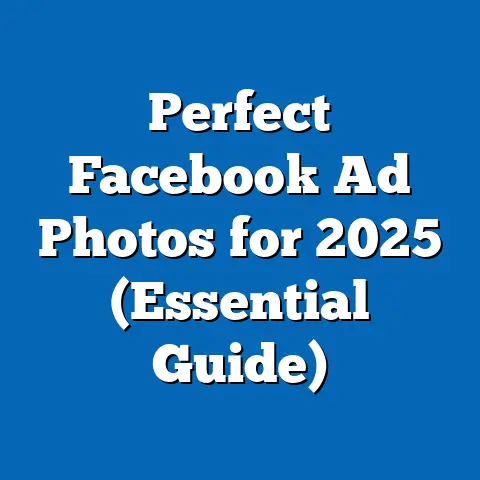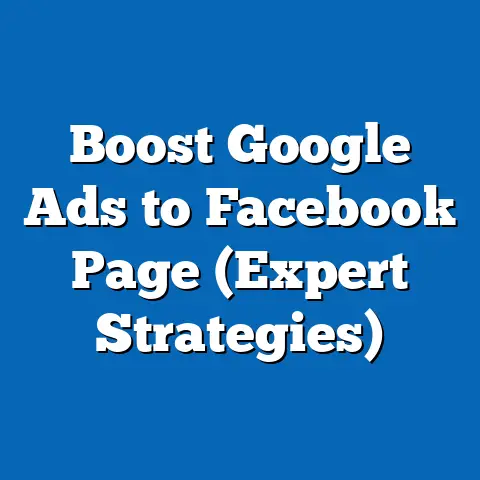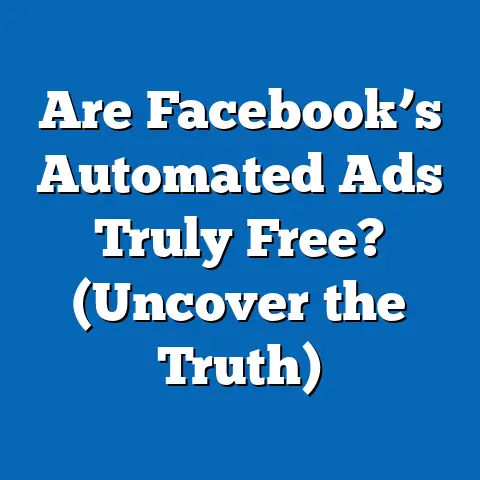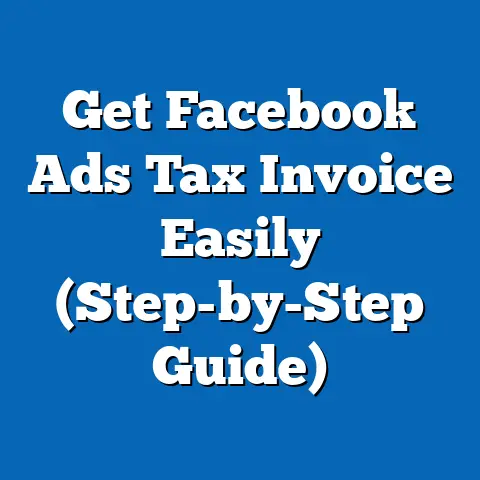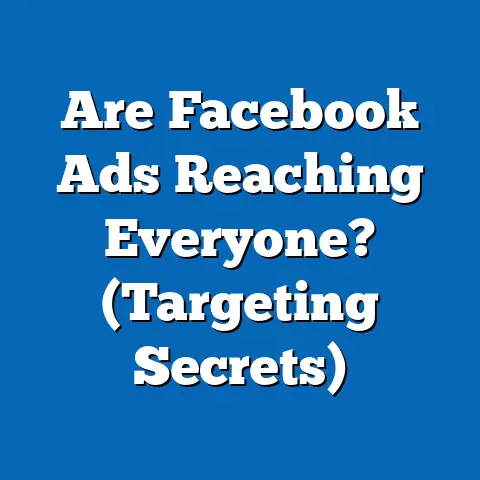Boosting Facebook Gaming Ads (Proven Strategies to Win)
I’ve always admired true craftsmanship. Whether it’s a perfectly crafted piece of furniture or a meticulously designed watch, there’s something captivating about the dedication and skill that goes into creating something truly exceptional. It’s not just about following instructions; it’s about understanding the materials, anticipating the challenges, and pouring your heart into the work. In many ways, crafting effective Facebook gaming ads is similar. It requires a deep understanding of the platform, a keen eye for detail, and a willingness to experiment and refine your approach.
Facebook gaming ads are no longer just a nice-to-have; they’re a critical component of any successful game marketing strategy. The gaming industry is booming, with projections estimating it will reach over $300 billion by 2025 (Source: Newzoo). And within that massive market, Facebook remains a significant player, connecting developers and marketers with millions of potential players worldwide. However, simply throwing money at Facebook ads won’t guarantee success. To truly stand out and achieve a positive return on investment, you need a well-defined strategy, compelling creatives, and a deep understanding of your target audience.
This isn’t just about slapping together a quick ad and hoping for the best. I’m talking about crafting compelling narratives that resonate with gamers, building a community around your game, and leveraging the power of Facebook’s targeting options to reach the right players at the right time.
By the end of this article, you’ll have the knowledge and tools you need to elevate your Facebook gaming ads and achieve real, measurable results. Let’s dive in!
Understanding the Facebook Gaming Ecosystem
Before you start throwing ads together, it’s crucial to understand the Facebook gaming landscape. It’s not just about knowing that people play games on Facebook; it’s about understanding how they play, what they play, and why they play.
According to Facebook’s own data, there are over 380 million people engaging with gaming content on the platform every month. This includes playing games, watching live streams, and participating in gaming communities. And the demographics are diverse, ranging from casual mobile gamers to hardcore PC enthusiasts. This massive audience presents a huge opportunity for game developers and marketers, but it also means that you need to be strategic about how you reach them.
I remember when I first started running Facebook ads for a mobile game client. I assumed that all gamers were the same and targeted my ads broadly. The results were disastrous. My click-through rates were low, and my conversion rates were even lower. It wasn’t until I started segmenting my audience based on their interests, behaviors, and demographics that I started to see real improvements.
One of the keys to success is understanding the different types of gaming ads available on Facebook. Here’s a quick overview:
- In-stream Ads: These are short video ads that play before, during, or after live streams and gaming videos. They’re a great way to reach a captive audience, but they need to be engaging and relevant to avoid being skipped.
- Playable Ads: These interactive ads allow users to try out a mini-version of your game directly within the Facebook app. They’re highly engaging and can be a great way to drive downloads and installs.
- Video Ads: These are standard video ads that appear in users’ newsfeeds. They’re a versatile option that can be used to showcase gameplay, highlight features, and tell stories.
- Image Ads: These are simple image ads that can be used to promote your game. While they’re not as engaging as video ads, they can be effective if you have a compelling visual and a strong call to action.
Each of these ad formats has its own unique advantages and disadvantages. In-stream ads are great for reaching a highly engaged audience, but they can be expensive. Playable ads are highly engaging, but they require more development effort. Video ads are versatile, but they need to be well-produced to stand out. Image ads are simple, but they can be easily ignored.
Another critical factor to consider is the competitive environment. The gaming industry is incredibly crowded, with new games being released every day. This means that you need to be creative and strategic to stand out from the crowd. Understanding what your competitors are doing, what’s working for them, and what’s not working for them can give you a significant advantage.
Key Takeaways:
- Facebook is a massive platform for gaming, with a diverse audience of millions of players.
- Different types of gaming ads are available, each with its own unique advantages and disadvantages.
- The gaming industry is highly competitive, so you need to be strategic to stand out.
- Next Step: Research the different types of gaming ads available on Facebook and identify the ones that are most relevant to your game and target audience. Analyze your competitors’ Facebook ad strategies to identify opportunities for differentiation.
Crafting the Perfect Ad Creative
Now that you understand the Facebook gaming ecosystem, it’s time to focus on crafting the perfect ad creative. This is where the artistry comes in. Your ad creative is the first thing that potential players will see, so it needs to be visually appealing, engaging, and relevant to their interests.
I’ve seen countless gaming ads that are poorly designed, poorly written, and completely irrelevant to the target audience. These ads are a waste of money and can even damage your brand reputation. On the other hand, I’ve also seen gaming ads that are so creative and compelling that they generate massive buzz and drive tons of downloads.
So, what makes an ad creative great? Here are some key components:
- Visuals: Your visuals should be eye-catching and relevant to your game. Use high-quality images or videos that showcase gameplay, characters, and environments. Avoid using generic stock photos or videos that don’t represent your game. If you’re creating a video ad, make sure it’s well-produced and edited.
- Copy: Your ad copy should be concise, clear, and compelling. Highlight the unique features and benefits of your game. Use strong verbs and action words to create excitement. Avoid using jargon or technical terms that your target audience may not understand.
- Call to Action: Your call to action should be clear and direct. Tell users exactly what you want them to do, such as “Download Now,” “Play Now,” or “Learn More.” Use a visually prominent button or link to make it easy for users to take action.
Storytelling is a powerful tool that can be used to create engaging ad creatives. Gamers are drawn to immersive narratives and compelling characters. Incorporate elements of your game’s story into your ads to pique their interest and make them want to learn more.
For example, instead of just showing gameplay footage, you could create a short video that tells the story of one of your game’s characters. Or, you could create an image ad that features a key moment from the game’s narrative.
Community is also a critical element to consider. Gamers are passionate about their communities, and they’re more likely to engage with ads that feel authentic and relevant to their interests. Incorporate elements of your game’s community into your ads to create a sense of belonging.
For example, you could feature user-generated content in your ads, such as screenshots or videos of players enjoying your game. Or, you could create ads that highlight community events and tournaments.
When it comes to video ads, there are a few best practices to keep in mind:
- Length: Keep your video ads short and sweet. Aim for 15-30 seconds.
- Pacing: Use fast-paced editing and music to keep viewers engaged.
- Emotional Hooks: Use emotional hooks to connect with viewers on a deeper level. Show them why your game is fun, exciting, or meaningful.
A/B testing is essential for finding the most effective ad creatives. Experiment with different visuals, copy, and calls to action to see what resonates best with your target audience. Use Facebook’s A/B testing tools to track the performance of your different ad variations and identify the winners.
I once ran an A/B test for a mobile game ad campaign where I tested two different video ads: one that focused on the game’s graphics and another that focused on the game’s storyline. I was surprised to find that the ad focusing on the storyline performed significantly better, even though the game had stunning graphics. This taught me the importance of testing different approaches and not making assumptions about what will resonate with your target audience.
Key Takeaways:
- Your ad creative is the first thing that potential players will see, so it needs to be visually appealing, engaging, and relevant.
- Use high-quality visuals, concise copy, and a clear call to action.
- Incorporate storytelling techniques and community elements into your ads.
- Follow best practices for video ads, including length, pacing, and emotional hooks.
- A/B test different ad creatives to find the most effective combinations.
- Next Step: Brainstorm different ad creative ideas based on your game’s unique features, story, and community. Create multiple variations of your ads and use Facebook’s A/B testing tools to identify the winners.
Targeting the Right Audience
Even the most creative and compelling ad will fail if it’s not shown to the right audience. This is where Facebook’s advanced targeting options come into play. Facebook allows you to target users based on a wide range of factors, including their interests, behaviors, demographics, and even their connections.
I’ve seen many marketers make the mistake of targeting their ads too broadly. They assume that anyone who plays games is a potential customer, so they target their ads to everyone who has an interest in gaming. This is a waste of money and can lead to low click-through rates and conversion rates.
Instead, you need to be strategic about your targeting. Think about who your ideal player is. What are their interests? What are their behaviors? What are their demographics? Once you have a clear picture of your ideal player, you can use Facebook’s targeting options to reach them.
Here are some of the most effective targeting options for gaming ads:
- Interests: Target users who have an interest in specific games, genres, or gaming-related topics. For example, you could target users who have an interest in “Fortnite,” “Call of Duty,” or “Esports.”
- Behaviors: Target users who have demonstrated specific behaviors related to gaming, such as playing games regularly, watching gaming videos, or participating in gaming communities.
- Demographics: Target users based on their age, gender, location, education, and other demographic factors.
- Connections: Target users who are connected to your Facebook page or who are friends with people who play your game.
Audience segmentation is essential for maximizing the effectiveness of your targeting. Don’t treat all gamers the same. Segment your audience based on their interests, behaviors, and demographics to create more targeted ads that resonate with them.
For example, you could create separate ad campaigns for casual mobile gamers, hardcore PC enthusiasts, and fans of specific game genres. This will allow you to tailor your ads to each segment’s unique interests and needs.
Lookalike audiences are a powerful tool for expanding your reach and finding new potential players. Facebook allows you to create lookalike audiences based on your existing customers or website visitors. This means that Facebook will identify users who share similar characteristics and behaviors with your existing customers and target your ads to them.
Retargeting campaigns are a great way to re-engage users who have already shown an interest in your game. For example, you could retarget users who have visited your website, watched your videos, or downloaded your game’s demo. This will allow you to remind them about your game and encourage them to take action.
I remember working with a client who was struggling to get downloads for their new mobile game. We implemented a retargeting campaign targeting users who had visited their website but hadn’t downloaded the game. We created a compelling video ad that highlighted the game’s unique features and included a clear call to action. The results were amazing. We saw a significant increase in downloads and a dramatic improvement in our return on ad spend.
Key Takeaways:
- Targeting the right audience is essential for the success of your Facebook gaming ads.
- Use Facebook’s advanced targeting options to reach users based on their interests, behaviors, demographics, and connections.
- Segment your audience based on their interests, behaviors, and demographics to create more targeted ads.
- Use lookalike audiences to expand your reach and find new potential players.
- Implement retargeting campaigns to re-engage users who have already shown an interest in your game.
- Next Step: Define your ideal player and identify the targeting options that will allow you to reach them. Create separate ad campaigns for different audience segments and use lookalike audiences to expand your reach.
Leveraging Facebook Analytics and Insights
Once your ads are running, it’s crucial to track their performance and gather insights. Facebook Ads Manager provides a wealth of data that can help you understand what’s working, what’s not working, and how to optimize your campaigns for better results.
I’ve seen many marketers make the mistake of setting up their ads and then forgetting about them. They don’t track their performance, they don’t gather insights, and they don’t make any changes to their campaigns. This is a recipe for disaster.
Instead, you need to be proactive about tracking your ad performance. Monitor your key metrics regularly and make adjustments to your campaigns based on the data.
Here are some of the key metrics to focus on for gaming ads:
- Click-Through Rate (CTR): This is the percentage of users who click on your ad after seeing it. A high CTR indicates that your ad is relevant and engaging to your target audience.
- Conversion Rate (CVR): This is the percentage of users who take a desired action after clicking on your ad, such as downloading your game, making a purchase, or signing up for your email list. A high CVR indicates that your ad is effective at driving conversions.
- Cost Per Click (CPC): This is the average cost you pay each time someone clicks on your ad. A low CPC indicates that your ad is efficient at driving traffic to your website or app store.
- Return on Ad Spend (ROAS): This is the amount of revenue you generate for every dollar you spend on advertising. A high ROAS indicates that your ad campaigns are profitable.
- Cost Per Install (CPI): This is the average cost you pay for each install of your game that results from your ad campaign.
Interpreting data and making informed decisions based on performance metrics is crucial for optimizing your ad campaigns. If your CTR is low, it may indicate that your ad creative is not engaging enough. If your CVR is low, it may indicate that your landing page is not optimized for conversions. If your CPC is high, it may indicate that your targeting is too broad. If your ROAS is low, it may indicate that your ad campaigns are not profitable.
Based on these insights, you can make adjustments to your ad creative, targeting, and bidding strategy to improve your results.
For example, if you notice that your CTR is low, you could try testing different ad creatives or targeting a more specific audience. If you notice that your CVR is low, you could try optimizing your landing page or offering a special promotion. If you notice that your CPC is high, you could try narrowing your targeting or lowering your bids.
Continuous improvement is the key to success with Facebook gaming ads. Regularly track your performance, gather insights, and make adjustments to your campaigns based on the data. Over time, you’ll learn what works best for your game and your target audience.
I once worked with a client who was running Facebook ads for a new online multiplayer game. They were seeing decent traffic to their website, but their conversion rates were low. After analyzing their data, we discovered that most of their traffic was coming from mobile devices, but their website wasn’t optimized for mobile users. We immediately optimized their website for mobile devices, and their conversion rates skyrocketed. This taught me the importance of not just tracking your ad performance, but also analyzing your website data to identify areas for improvement.
Key Takeaways:
- Track your ad performance regularly using Facebook Ads Manager.
- Focus on key metrics such as CTR, CVR, CPC, and ROAS.
- Interpret data and make informed decisions based on performance metrics.
- Optimize your ad campaigns based on analytical findings for continuous improvement.
- Next Step: Set up Facebook Ads Manager to track your ad performance. Monitor your key metrics regularly and make adjustments to your campaigns based on the data.
Engaging the Gaming Community
Building a community around your game is crucial for long-term success. A strong community can provide valuable feedback, generate word-of-mouth marketing, and drive engagement with your game. Facebook ads can be a powerful tool for driving engagement with your community.
I’ve seen many gaming brands successfully use Facebook ads to build and engage their communities. They use ads to promote community events, highlight user-generated content, and encourage players to connect with each other.
Facebook Groups, events, and live streams can be powerful tools for engaging your gaming community. Create a Facebook Group for your game where players can connect with each other, share their experiences, and provide feedback. Use Facebook Events to promote community events, such as tournaments, meetups, and live streams. Use Facebook Live to stream gameplay, Q&A sessions, and other engaging content.
For example, you could create a Facebook Group for your game where players can share their screenshots, videos, and stories. You could use Facebook Events to promote a weekly tournament or a monthly meetup. You could use Facebook Live to stream gameplay footage and answer questions from your community.
Encouraging user-generated content and testimonials can enhance your ad credibility and drive engagement. Ask your players to share their screenshots, videos, and stories about your game. Feature this user-generated content in your ads to show potential players what others are saying about your game.
For example, you could create an ad that features a compilation of the best user-generated screenshots from your game. Or, you could create an ad that features a testimonial from a satisfied player.
I remember working with a client who was struggling to build a community around their new mobile game. We launched a Facebook ad campaign that encouraged players to share their best gameplay moments on the game’s Facebook page. We offered a small prize for the best submission each week. The results were amazing. We saw a huge increase in user-generated content, and our Facebook page became a thriving hub for the game’s community.
Key Takeaways:
- Building a community around your game is crucial for long-term success.
- Use Facebook ads to drive engagement with your community.
- Leverage Facebook Groups, events, and live streams to connect with your players.
- Encourage user-generated content and testimonials to enhance your ad credibility.
- Next Step: Create a Facebook Group for your game and start promoting it through your ads. Use Facebook Events to promote community events and Facebook Live to stream engaging content.
Navigating Challenges in Facebook Gaming Ads
Facebook gaming ads can be incredibly effective, but they also come with their own set of challenges. Understanding these challenges and having strategies to overcome them is essential for success.
One common challenge is ad fatigue. Over time, your target audience may become tired of seeing the same ads over and over again. This can lead to lower click-through rates and conversion rates.
To overcome ad fatigue, it’s important to refresh your ad creatives regularly. Experiment with different visuals, copy, and calls to action. Try using different ad formats or targeting different audience segments.
Another challenge is algorithm changes. Facebook’s advertising algorithms are constantly evolving, and these changes can impact the performance of your ads.
To adapt to algorithm changes, it’s important to stay up-to-date on the latest news and trends in Facebook advertising. Follow industry blogs, attend webinars, and experiment with new features and strategies.
Changes in Facebook’s advertising policies can also impact gaming ads. Facebook has strict policies about what types of ads are allowed on the platform, and these policies can change over time.
To maintain compliance, it’s important to familiarize yourself with Facebook’s advertising policies and ensure that your ads comply with these policies.
I remember when Facebook changed its advertising policies to restrict the promotion of loot boxes in games. This had a significant impact on many gaming brands that relied on loot boxes as a monetization strategy. We had to quickly adapt our ad campaigns to comply with the new policies, which required us to focus on other aspects of the game, such as its gameplay and story.
Pushing creative boundaries while maintaining compliance is a delicate balance. You want your ads to stand out and grab attention, but you also need to make sure that they comply with Facebook’s advertising policies.
To push creative boundaries while maintaining compliance, it’s important to understand the spirit of Facebook’s advertising policies. Focus on creating ads that are engaging, informative, and relevant to your target audience, without violating any of Facebook’s rules.
Key Takeaways:
- Be aware of common challenges in Facebook gaming ads, such as ad fatigue and algorithm changes.
- Refresh your ad creatives regularly to overcome ad fatigue.
- Stay up-to-date on the latest news and trends in Facebook advertising to adapt to algorithm changes.
- Familiarize yourself with Facebook’s advertising policies to maintain compliance.
- Push creative boundaries while maintaining compliance by understanding the spirit of Facebook’s advertising policies.
- Next Step: Create a plan for refreshing your ad creatives regularly. Stay up-to-date on the latest news and trends in Facebook advertising and familiarize yourself with Facebook’s advertising policies.
Conclusion
Crafting successful Facebook gaming ads is a blend of art and science. It requires a deep understanding of the Facebook gaming ecosystem, a keen eye for detail, and a willingness to experiment and refine your approach. It’s about crafting compelling narratives that resonate with gamers, building a community around your game, and leveraging the power of Facebook’s targeting options to reach the right players at the right time.
I’ve shared with you proven strategies that can transform your campaigns from mere promotions into powerful tools for engagement and conversion. Remember to:
- Understand the Facebook gaming ecosystem and identify the ad formats that are most relevant to your game and target audience.
- Craft compelling ad creatives that are visually appealing, engaging, and relevant to your target audience.
- Target the right audience by using Facebook’s advanced targeting options and segmenting your audience based on their interests, behaviors, and demographics.
- Leverage Facebook analytics and insights to track your ad performance and optimize your campaigns for better results.
- Engage the gaming community by creating a Facebook Group for your game, promoting community events, and encouraging user-generated content.
- Navigate common challenges in Facebook gaming ads, such as ad fatigue and algorithm changes, by refreshing your ad creatives regularly and staying up-to-date on the latest news and trends in Facebook advertising.
Now, it’s time to take action. Start implementing these strategies in your own Facebook gaming ad campaigns. Experiment with different approaches and find what resonates best with your target audience. Don’t be afraid to try new things and push creative boundaries.
The world of Facebook gaming ads is constantly evolving, so it’s important to stay curious, keep learning, and never stop experimenting. With dedication, skill, and a little bit of artistry, you can craft Facebook gaming ads that drive engagement, build community, and achieve real, measurable results. So go out there and create something amazing!

